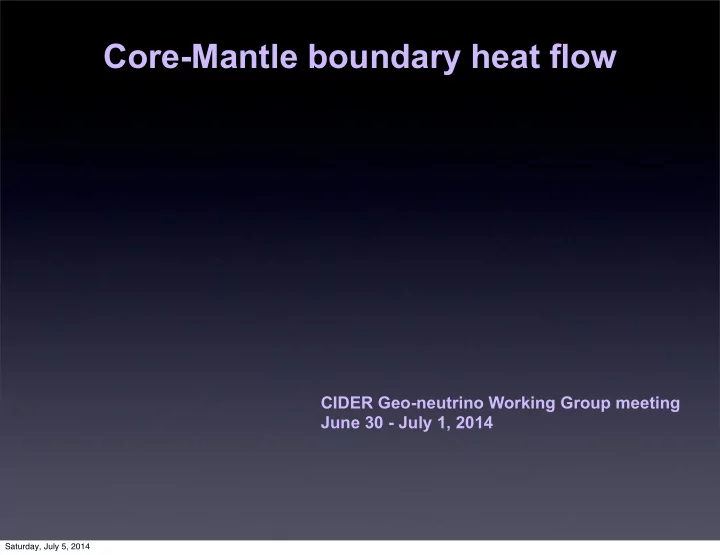

Core-Mantle boundary heat flow CIDER Geo-neutrino Working Group meeting June 30 - July 1, 2014 Saturday, July 5, 2014
CMB Heat flow estimates Fourier’s Law Approach 3D q = -k ∇ T Spatial Heat flux Temperature gradient thermal conductivity See review: Lay et al. 2008 Saturday, July 5, 2014
CMB Heat flow estimates Fourier’s Law Approach 1D Temperature Mantle T 2 r 2 r 1 T 1 Core q = -k dT/dr Heat flux Temperature gradient thermal conductivity See review: Lay et al. 2008 Saturday, July 5, 2014
CMB Heat flow estimates Fourier’s Law Approach 1D Temperature Mantle T 2 r 2 r 1 T 1 Core T 1 : Core Temperature at top of Core Anzellini et al • T of inner core boundary can be estimated 2013 by experimental determination of melting curve of Iron • Extrapolate that T along the adiabat to the CMB • T CMB = 4050 +/- 500 K (Anzellini et al 2013) Saturday, July 5, 2014
CMB Heat flow estimates Fourier’s Law Approach 1D Temperature Mantle T 2 r 2 r 1 T 1 Core T 2 : Mantle Temperature above CMB • Similarly T at 660 phase transition and at post-perovskite transition can be estimated experimentally • Extrapolate that T along the adiabat to the CMB gives 2,500-2,800 K Saturday, July 5, 2014
CMB Heat flow estimates Fourier’s Law Approach 1D Temperature Mantle T 2 r 2 r 1 T 1 Core r 2 - r 1 : Boundary Layer Thickness • ~100-200 km • For perspective, top thermal boundary layer is 90-100 km (taking the lithosphere to be the boundary layer) Saturday, July 5, 2014
CMB Heat flow estimates Fourier’s Law Approach 1D Temperature Mantle T2 r2 k r1 Core T1 k: Thermal Conductivity of lower mantle material • ~10 W/m/K • could be laterally heterogeneous due to compositional and phase variability • Ppv is anisotropic Saturday, July 5, 2014
CMB Heat flow estimates Fourier’s Law Approach 1D Temperature Mantle T2 r2 r1 Core T1 Result • 10 - 15 TW • 3-5 times larger than estimates pre-2008 Saturday, July 5, 2014
CMB Heat flow estimates Geomagnetic Constraints • Core fluid motions strongly influenced by Q cmb • Fluid motions, in turn, drive a geodynamo which gives rise to a magnetic field observable at Earth’s surface • Earth’s magnetic field present at least 3.5 Gyr Saturday, July 5, 2014
CMB Heat flow estimates Geomagnetic Constraints • If CMB heat flow exceeds core adiabatic heat flow, downwellings from the CMB are generated which facilitate whole layer stirring Buffett 2012 CIDER presentation Convective style for: Q cmb > Q ad Q CMB cooling Qa Saturday, July 5, 2014
CMB Heat flow estimates Geomagnetic Constraints • If CMB heat flow is less than core adiabatic heat flow, core can develop thermal stratification at top; convection driven by inner core growth Buffett 2012 CIDER presentation Convective style for: Q cmb Q cmb < Q ad CMB Q ad Q CMB light warming elements latent inner Qa heat core Saturday, July 5, 2014
CMB Heat flow estimates Geomagnetic Constraints Q ad • 2012 results from ab initio calculations find thermal conductivity of core 2-3 times greater than previous estimates • Q ad = 15-16 TW • higher than many estimates of Q cmb Pozzo et al 2012 Saturday, July 5, 2014
CMB Heat flow estimates Geomagnetic Constraints Evidence for stratified layer at top of Core? • Decadal variations of magnetic field may show distinctive periodicities • 140 km stratified layer at top of core can reproduce geomagnetic field observations • Implication is 13TW (subadiabatic) Qcmb Buffett 2014 Saturday, July 5, 2014
CMB Heat flow estimates Geomagnetic Constraints CMB influence on geomagnetic field structure Scalar magnetic field at Earth’s surface: 7,000 year average Present field (10 years ago) 51 51 39 39 27 27 15 15 3 3 (a) Average CALS7K.2 B at r=a (b) 2000 AD, OSVM B at r=a (GAD) fig. from Constable (2007) S N Saturday, July 5, 2014
CMB Heat flow estimates Geomagnetic Constraints • Present day and historical magnetic field show high latitude flux lobes which move around but recur at preferred longitudes • Could be explained by heterogeneous heat flow at CMB • This result assumes/implies Vs at CMB is result of thermal variability Observed Field in 1990 (Br plotted) Dynamo model imposing heterogeneous CMB heat flow Gubbins et al. 2007 Saturday, July 5, 2014
CMB Heat flow estimates Geomagnetic Constraints • Siberian lobe dominant, leading to average dipole tilt (10 deg.) Olson et al. 2013 • High heat flux regions lead to downwellings which concentrate magnetic field into high intensity patches • Note: localized downwellings can lead to widespread core mixing in presence of average stratification Saturday, July 5, 2014
CMB Heat flow estimates Geomagnetic Constraints Olson et al. 2013 • Through time: GPTS reversal frequency indicates time dependent CMB heterogeneity • Through time: magnetic field strength variations anti- correlated with kinematic energy of convection Ziegler et al., GJI (2011) Brunhes Matuyama Jaramillo Olduvai Cobb Magnetic Strength Mean: 6.2 Mean: 4.8 Today 2 Million years ago Saturday, July 5, 2014
CMB Heat flow Discussion Points • Geodynamic considerations give a plausible range for CMB heat flow of 10-15 TW for present day • Total CMB heat flow estimates from geomagnetic considerations indicate present day values which are marginally subadiabatic • Pattern of non-dipole geomagnetic field structure possibly explained by heterogeneous CMB heat flow • Paleo-earth: • Is modern-day CMB seismic velocity (and/or heat flow) pattern the same as in the past? • Was the past CMB heat flow superadiabatic such that core convection and dynamo action could occur in the absence of the inner core? For 3 Gyr? Saturday, July 5, 2014
Recommend
More recommend